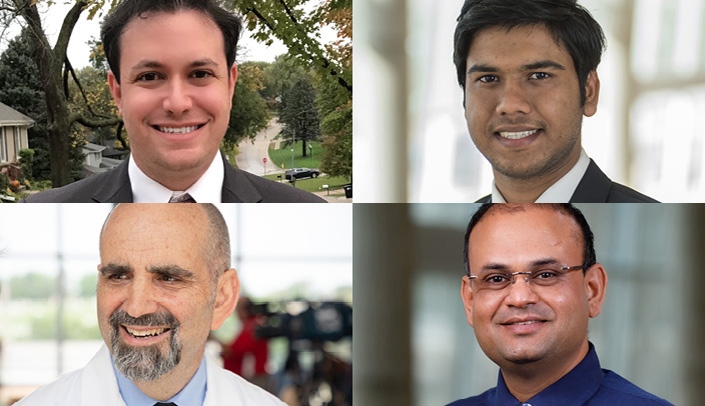A team of UNMC researchers eliminated the human immunodeficiency virus type one (HIV-1) in a laboratory at a genetic level by gene editing based "intracellular molecular surgery."
The new study was conducted by a team that included Howard Gendelman, MD, Jonathan Herskovitz, PhD, Mahmudul Hasan, Bhavesh Kevadiya, PhD, and colleagues from the UNMC Department of Pharmacology and Experimental Neuroscience.
The therapy contained a biocompatible lipid nanoparticle (LNP) carrying a CRISPR viral excision cargo. That cargo allowed editing of five separate HIV-1 DNA segments. This was in contrast to the earlier studies which targeted one gene and as such decreased the likelihood that the deleted viral genome would recombine and replicate after the intervention was completed.
The study, published today in the journal EBioMedicine by Lancet, builds on work first unveiled two years ago. In the prior work, a UNMC team, working in a prior collaboration with Temple University investigators, successfully eliminated HIV-1 in a subset of live animals.
The team developed a novel delivery platform to excise HIV-1 integrated into the cell genome based on CRISPR technology. The system allowed the therapy to reach then eliminate latent virus inside cells.
The results obtained paves the way for animal testing.
The carriage of the molecular therapy enables the genetic medicines to efficiently cross lymphocyte and macrophage cell membranes. Then the molecular therapy in the form of ribonucleic acid or mRNA is released. The system is a significant improvement over earlier HIV elimination strategy which used a viral vector by its abilities to reduce potential toxicities and administrative volumes and to improve cell targeting.
"Two years ago, we delivered maximal therapeutic agents to all the cells in the body. To achieve that, we used a virus to deliver the therapeutic agent," said Dr. Gendelman, chair of the department and head of the UNMC Global Virus Network Center of Excellence. The efficiency and targeting of the system can be optimized for future human testing.
In the new study, the research team developed new tools to attack more than one area of the genome, using CRISPR technology to create the guide RNAs, said Dr. Herskovitz, a co-lead author on the study.
"We developed molecular tools against many different parts of the HIV genome, so we were able to cut multiple genes out, which reduces the chance that the virus is going to replicate again," he said. "This is a molecular surgery procedure that can attack multiple parts of HIV simultaneously."
The improved delivery system replaces a virus — which, Hasan, a co-lead author said, could potentially cause toxicities itself in high concentrations — with biologically compatible materials such as lipids and cholesterol. Notably, the similar lipid nanoparticles have been used successfully for the delivery of mRNA vaccines now in clinical use against COVID-19.
"These results," the authors say in the paper, "provide ‘proof of concept’ for CRISPR gRNAs treatments for complete HIV elimination."
"We are using the lipid biomaterials to improve the effectiveness of our delivery system and produce a more effective, sensitive, specific and stable product," Dr. Kevadiya said. "At the cellular level, we have recorded a high efficiency of our delivery system — these LNPs provide the cell the "molecular surgery tools" that are needed to knock out HIV-1."
Robert C. Gallo, MD, the Homer & Martha Gudelsky Distinguished Professor in Medicine, co-founder & director, Institute of Human Virology at the University of Maryland School of Medicine; co-founder & international scientific director, Global Virus Network, said:
"Howard Gendelman and his colleagues at the University of Nebraska Medical Center have been doing forefront research on future HIV therapy. I know of no more rational and no better approach than he and his team have advanced."
Christian Brechot, MD, president of the Global Virus Network and president emeritus of The Institut Pasteur, called the team’s approach "bold."
"Howard Gendelman and his team have provided major breakthroughs for the treatment of HIV and in fact the future of many infectious diseases," Dr. Brechot said. "Their bold approach to take advantage of technologic progress and develop novel therapies is exactly consistent with the spirit of the Global Virus Network."
One of the paper's reviewers said the data "will be paradigm-shifting in terms of the elimination of latent HIV-1."
The next steps for the team are to move to animal models.
"Now that we have something sensitive, specific and effective, we are able to move this into animals," Dr. Gendelman said. "If the interventions work as we think they will, following the FDA approvals, we hope ultimately to move this to human trials. The increased specificity and lower toxicities, we believe, show that we now have a means to translate these interventions to people. It is exciting to be a part of this research effort."

Congratulations
Kudos to Mahmudal Hasan, who arrived in the US just three years ago as a new international student from Bangladesh! What a great accomplishment for this budding scientist, who is the current president of UNMC's International Student Association and is completing a prestigious internship with Moderna.
Congratulations, especially to Mahmudal Hasan!
A game changer in HIV battle…Congratulations to the team!
Awesome work by the whole team. Take a bow!
Man many congratulation team!
What about collaboration with LASER ART developed at UNMC and CRISPR technology at Temple University?